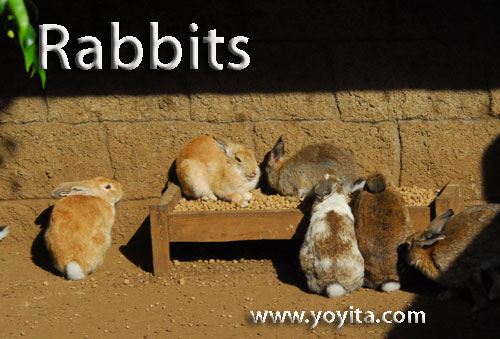Rabbits
Scientific classification of rabbits
Kingdom: Animalia
Phylum: Chordata
Class: Mammalia
Order: Lagomorpha
Family: Leporidae
in part Genera of Rabbits
Pentalagus
Bunolagus
Nesolagus
Romerolagus
Brachylagus
Sylvilagus
Oryctolagus
Poelagus
Rabbits are small mammals in the family Leporidae of the order Lagomorpha, found in several parts of the world. There are seven different genera in the family classified as rabbits, including the European Rabbit (Oryctolagus cuniculus), cottontail rabbits (genus Sylvilagus; 13 species), and the Amami Rabbit (Pentalagus furnessi, an endangered species on Amami Oshima, Japan). There are many other species of rabbit, and these, along with cottontails, pikas and hares make up the Order Lagomorpha. Rabbits generally live between four and 10 years. A rabbit's gestation period is 31 days
Rabbits are clearly distinguished from hares in that rabbits are altricial, having young that are born blind and hairless. In contrast, hares are generally born with hair and are able to see. All rabbits (except the cottontail rabbit) live underground in burrows or warrens, while hares live in simple nests above the ground (as does the cottontail rabbit), and usually do not live in groups. Hares are generally larger than rabbits, with longer ears, and have black markings on their fur. Hares have not been domesticated, while rabbits are often kept as house pets. In gardens, they are typically kept in hutches, small, wooden, house-like boxes that protect the rabbits from the environment and predators.
Lifespan
A healthy indoor pet rabbit can live up to 10 years and longer. They enjoy throwing around toys and chewing on cardboard. In some home environments, they can develop an affinity with cats and even dogs. Though they are often caged in small areas, they can be trained to live as free-roaming pets, similar to cats and dogs. As pet rabbit medicine, diet and living environment improves, the rabbit's life span increases.
Classification of Rabbits:
Rabbits and hares were formerly classified in the order Rodentia (rodent) until 1912, when they were moved into a new order Lagomorpha. This order also includes pikas.
Order Lagomorpha
* Family Leporidae
o Genus Pentalagus
+ Amami Rabbit/Ryukyu Rabbit, Pentalagus furnessi
o Genus Bunolagus
+ Bushman Rabbit, Bunolagus monticularis
o Genus Nesolagus
+ Sumatra Short-Eared Rabbit, Nesolagus netscheri
+ Annamite Rabbit, Nesolagus timminsi
o Genus Romerolagus
+ Volcano Rabbit, Romerolagus diazi
o Genus Brachylagus
+ Pygmy Rabbit, Brachylagus idahoensis
o Genus Sylvilagus
+ Forest Rabbit, Sylvilagus brasiliensis
+ Dice's Cottontail, Sylvilagus dicei
+ Brush Rabbit, Sylvilagus bachmani
+ San Jose Brush Rabbit, Sylvilagus mansuetus
+ Swamp Rabbit, Sylvilagus aquaticus
+ Marsh Rabbit, Sylvilagus palustris
+ Eastern Cottontail, Sylvilagus floridanus
+ New England Cottontail, Sylvilagus transitionalis
+ Mountain Cottontail, Sylvilagus nuttallii
+ Desert Cottontail, Sylvilagus audubonii
+ Omilteme Cottontail, Sylvilagus insonus
+ Mexican Cottontail, Sylvilagus cunicularis
+ Tres Marias Rabbit, Sylvilagus graysoni
o Genus Oryctolagus
+ European Rabbit, Oryctolagus cuniculus
o Genus Poelagus
+ Central African Rabbit, Poelagus marjorita
o Three other genera in family, regarded as hares, not rabbits
Folklore and mythology
The rabbit often appears in folklore as the trickster archetype, as he uses his cunning to outwit his enemies.
* In Chinese literature, rabbits accompany Chang'e on the Moon. Also associated with the Chinese New Year (or Lunar New Year), rabbits are also one of the twelve celestial animals in the Chinese Zodiac for the Chinese calendar. It is interesting to note that the Vietnamese lunar new year replaced the rabbit with a cat in their calendar, as rabbits did not inhabit Vietnam.
* In Japanese tradition, rabbits live on the Moon where they make mochi, the popular snack of mashed sticky rice. This comes from interpreting the pattern of dark patches on the moon as a rabbit standing on tiptoes on the left pounding on an usu, a Japanese mortar (See also: Man in the moon). A popular culture manifestation of this tradition can be found in the character title character of Sailor Moon, whose name is Usagi Tsukino, a Japanese pun on the words "rabbit of the moon." Similarly, Japanese-American Stan Sakai's comic book character Usagi Miyamoto from Usagi Yojimbo is an anthropomorphized rabbit who is a samurai, based loosely on Japanese swordsman Miyamoto Musashi.
* In Aztec mythology, a pantheon of four hundred rabbit gods known as Centzon Totochtin, led by Ometotchtli or Two Rabbit, represented fertility, parties, and drunkenness.
* In Native American Ojibwe mythology, Nanabozho, or Great Rabbit, is an important deity releated to the creation of the world.
* In the folklore of the United States, a rabbit's foot is frequently carried as an amulet, and is often used as keychain, where it is thought to bring luck. The practice derives from the system of African-American folk magic called hoodoo.
* Easter bunny: During Easter a rabbit lays eggs.
* In Central Africa "Kalulu" the rabbit is widely known as a tricky character, getting the better of bargains.
When used for food, rabbits are both hunted and bred for meat. Snares or guns along with dogs are usually employed when catching wild rabbits for food. In many regions, rabbits are also bred for meat, a practice called cuniculture. Rabbits can then be killed by hitting the back of their heads, a practice from which the term rabbit punch is derived. Rabbit pelts are sometimes used in for clothing and accessories, such as scarves or hats. Rabbits are very good producers of manure; additionally, their urine, being high in nitrogen, makes lemon trees very productive. Their milk may also be of great medicinal or nutritional benefit due to its high protein content (see links below).
There are a number of health issues associated with the use of rabbits for meat, one of which is Tularemia or Rabbit Fever. Another is so-called rabbit starvation, due most likely to essential amino acid deficiencies in rabbit meat and synthesis limitations in human beings. |



